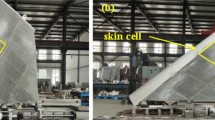Abstract
To meet the needs of morphing and withstand aerodynamic loads of a morphing wing skin, a corrugated glass fabric-epoxy laminated composite is prepared and investigated in this paper. This composite is flexible in the corrugated direction and stiff in the transverse direction to the corrugation. FEM models are established and solved to predict the characteristics of the composites by the commercial FEM software ANSYS. The relationship between the configuration of elongation and tensile load along the corrugation direction is obtained through numerical simulation. To reflect the stretching superiority of the configuration, the elongation of corrugated and flat composites is calculated and compared under the same tensile load. The linear cumulative effect of corrugated composites deformation is proved by calculating the elongation of the composites with several different corrugation numbers. Several corrugated composite specimens were manufactured and tested to verify the results of numerical analysis and the equivalent elastic modulus of the composites were also evaluated through the specimen tests. Results of simulation and experiments show that the corrugated composite provided in this paper can afford obviously larger deformation than the flat one. The corrugated composite can provide a possible choice for morphing wing skin.
Similar content being viewed by others
References
Ramrkahyani D S, Lesieutre G A, Frecker M, Bharti S. Aircraft structural morphing using tendon actuated compliant cellar trusses. AIAA, 2004, 1728
Yang S B, Xu M. Research on Flight control of a smart skin aircraft. Flight Dynamics, 2007, 25(1): 39–42 (in Chinese)
Perkins D A, Reed J L, Havens E. Morphing wing structures for loitering air vehicles. AIAA, 2004, 1888
Tomohiro Y, Shin-ichi T, Toshio O, Takashi I. Mechanical properties of corrugated composites for candidate materials of flexible wing structures. Composites, 2006, Part A, 37: 1578–1586
Lin D H, Pan D, Gao J, Chen S K. Applications of carbon fiber composite materials in the field of aerospace. FPR, 1997:18–28 (in Chinese)
Tao B Q, Shi L H, Xiong K, Liang Da Ki, Yuan S F. A smart composite structure system of self-diagnostic and self-adaptive strength. Journal of Applied Sciences, 1999, 17(1): 1–7 (in Chinese)
Rami H A, Joonho C, Wei B S, Roman P, Michael S. Refined nonlinear finite element models for corrugated fiberboards. Composite Structures Article, 2008 (in press)
Ellyin F, Kujawski D. Tensile and fatigue behaviour of glass fiber/epoxy laminates. Construction and Building Materials, 1995, 9: 6425–6430
Aboura Z, Talbi N, Allaoui S, Benzeggagh M L. Elastic behavior of corrugated cardboard: experiments and modeling. Composite Structures, 2004, 63: 53–62
Penga L X, Liewb K M, Kitipornchaib S. Analysis of stiffened corrugated plates based on the FSDT via the mesh-free method. International Journal of Mechanical Sciences, 2007, 49: 364–378
Sirajus S, Douglas L J. Fatigue response of thick section glass fiber/epoxy composites. Composite Structures, 2007, 79: 119–124
Author information
Authors and Affiliations
Corresponding author
Rights and permissions
About this article
Cite this article
Ge, R., Wang, B., Mou, C. et al. Deformation characteristics of corrugated composites for morphing wings. Front. Mech. Eng. China 5, 73–78 (2010). https://doi.org/10.1007/s11465-009-0063-4
Received:
Accepted:
Published:
Issue Date:
DOI: https://doi.org/10.1007/s11465-009-0063-4




